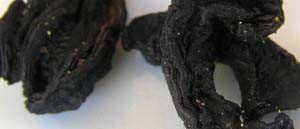‘The fruit is as big as an apple, and deeply ridged. In some trees it is yellow, in others red. When broken open there are two seeds, which to the teeth feel like leather, and are surrounded by a scarlet-coloured soft and frothy pulp, of a pleasant flavour, but seldom eaten, as in eating it the teeth become covered with a substance resembling bees-wax. An excellent jelly is made from it. The outside of the fruit is dried in the sun, and used by the natives in their curries.”
Rev J Selkirk, Recollections of Ceylon, 1884
Is there any flavouring less attractive to the eye than goraka? Selkirk’s description draws a discreet veil over what it looks like when you buy it. Well, here goes; catch a slug, put it in the sun till it is dessicated, deep browny black, wrinkled, leathery, squishy to touch, with a slightly putrid smell. Nice, eh! And yet, it’s one of those ingredients that is utterly transformed and transforming when added to a dish.
What is it? It’s the dried segments of the fruit of Garcinia gummi-gutta – a.k.a.gamboge – and it’s used as a souring agent in Sri Lanka and Southern Indian curries, particularly pork and fish curries. You have to soak it before adding it to curries, either whole or ground. It’s the main flavouring in the classic southern Sri Lankan dish ambul thiyal.
Happily, you can also now buy it as a paste in a jar in Sri Lankan providores, easier to use, less repulsive to have lying around your kitchen.
If you like fish but can’t stand the smell of it raw, washing the fish in water in which goraka has been soaking hides the smell of it.
If you use it whole, best to tell your guests not to chomp into it along with the fish or pork.
And yes, it is from the resin of the Garcinia species that the yellow pigment called gamboge comes.
